Mount Karisimbi is situated in the volcanoes national park of Rwanda, a renowned natural habitat for mountain gorillas. The mountain lies very close to the border between Rwanda and the Democratic Republic of Congo. Karisimbi is surrounded by other volcanoes within the Virunga ranges – Mount Bisoke to the east, Mikeno in the North and Nyiragongo to the west.
Mount Karisimbi is 4,507 meters high, making it the highest volcanic mountain within the Virunga massif and the 9th highest mountain in the whole of Africa. It is a dormant volcano with two craters at the top. Mutango is the biggest but it also has a caldera known as Branca. The name Karisimbi means “white coated top” in Kinyarwanda – in reference to the snow-capped peaks that can be visible on clear days of the year.
Hiking Mount Karisimbi
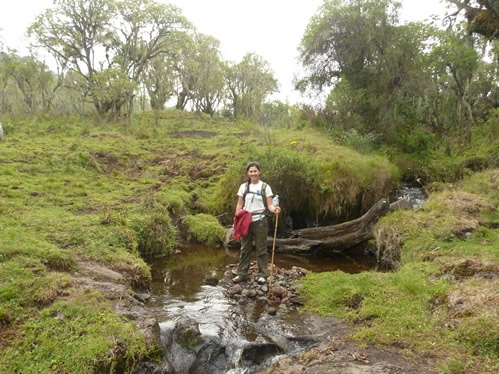 Being located in a biologically rich part of the Virunga conservation area has made Karisimbi a very popular hiking destination. It offers an amazing hiking experience with opportunities to marvel at the beautiful scenery of the Volcanoes National Park in Rwanda, other Virunga ranges and several wildlife conservation areas in Uganda and Congo. Along the trails, one can also encounter a plethora of primate species including the golden monkey and mountain gorillas. Apart from primates, hikers should also expect to encounter an amazing collection of birds and vegetation at the different sections of the mountain. You might also be interested in an article about gorilla tracking in the Volcanoes National Park.
Being located in a biologically rich part of the Virunga conservation area has made Karisimbi a very popular hiking destination. It offers an amazing hiking experience with opportunities to marvel at the beautiful scenery of the Volcanoes National Park in Rwanda, other Virunga ranges and several wildlife conservation areas in Uganda and Congo. Along the trails, one can also encounter a plethora of primate species including the golden monkey and mountain gorillas. Apart from primates, hikers should also expect to encounter an amazing collection of birds and vegetation at the different sections of the mountain. You might also be interested in an article about gorilla tracking in the Volcanoes National Park.
Is climbing Mount Karisimbi challenging?
Climbing mount Karisimbi is very challenging but worth every penny. For the best experience, it is recommended that one plans to hike during the dry season (June to October and December to March). The dry season allows for smoother hikes because the trails are less slippery. The rainy season can present great difficulty for hikers. They have to deal with loss of visibility due to fog, muddy paths and 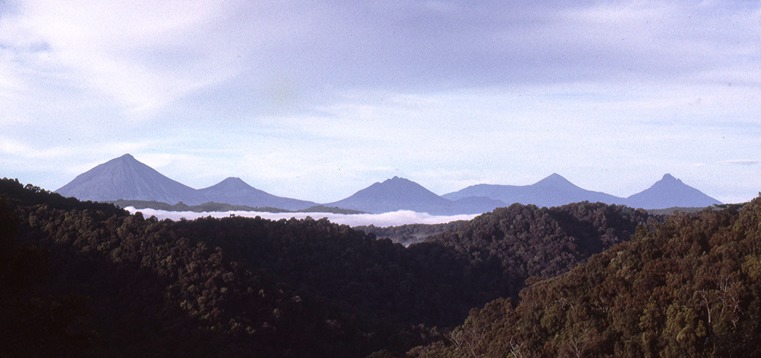 constant rains. These challenges may not be a problem to the seasoned mountain climber but inexperienced participants may end up not completing the trek.
constant rains. These challenges may not be a problem to the seasoned mountain climber but inexperienced participants may end up not completing the trek.
Regardless of the season, the mountain remains a challenge and one should expect steep and slant trails. A climber has to be in a very good condition both physically and mentally. If one is not well prepared, they might tire out and give up midway. An ill prepared hiker could also slow down the entire team due to heavy legs. This can affect the quality of the experience for everyone. For this reason, a hiker needs to prepare both physically and mentally before taking up the challenge of reaching the summit. The park management ensures that everything is available to make the experience as comfortable as possible. Those with heavy equipment or bags can always hire the services of a porter.
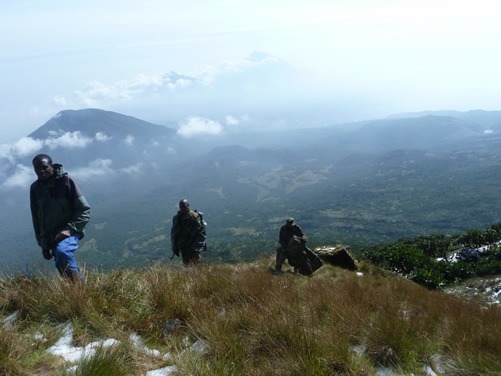 As already noted earlier, hiking Mount Karisimbi takes 2 days. This implies that a night is spent at the summit. The hike starts at sunrise and hikers should expect to reach the summit in the evening. On the day of the hike, everyone gathers at the volcanoes national park offices for briefing. During the briefing, the park rangers cover all important aspects of the hike including topics about the history of the mountain, the volcanoes national park, what to expect and safety issues. All hikers are required to fill in certain disclaimer and consent forms. After the briefing, all hikers are driven to the slopes of Mount Bisoke (the starting point of the hike).
As already noted earlier, hiking Mount Karisimbi takes 2 days. This implies that a night is spent at the summit. The hike starts at sunrise and hikers should expect to reach the summit in the evening. On the day of the hike, everyone gathers at the volcanoes national park offices for briefing. During the briefing, the park rangers cover all important aspects of the hike including topics about the history of the mountain, the volcanoes national park, what to expect and safety issues. All hikers are required to fill in certain disclaimer and consent forms. After the briefing, all hikers are driven to the slopes of Mount Bisoke (the starting point of the hike).
Getting to the summit of mount Karisimbi takes about 7 hours. While hiking mount Karisimbi, participants are allowed to take breaks to refresh or eat to gain back some of the lost calories before getting back to the track. At an elevation of about 3,000 meters above seas leave, hikers reach a designated campsite to rest for the night before proceeding to the summit (4700 meters) the following 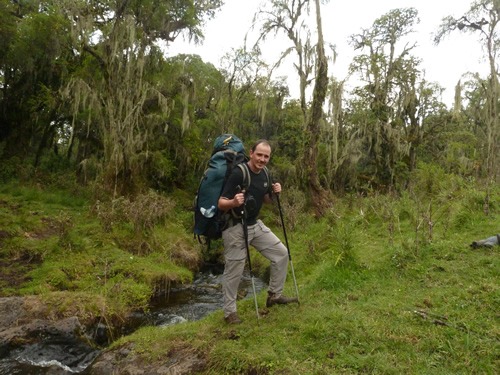 day. Reaching the summit is very rewarding to the hiker. It gives that feeling of contentment for conquering one of the highest mountains in Africa. Any fatigue is put aside as hikers gather to take photos of themselves at the crater and caldera. Hikers are also rewarded with jaw dropping views of the other volcanoes of the Virunga ranges including Bisoke, Gahinga, Sabyinyo, Mikeno, Nyamuragira, Nyiragongo and Muhabura. With their different shapes and sizes, these volcanoes are surrounded with eye catching vegetation, and beautiful volcanic features (craters and calderas). The Nyiragongo volcano is particularly amazing and one can see smoke coming out from the boiling magma at the summit. Apart from the volcanoes, hikers can see the beautiful national parks of Rwanda, Uganda and Congo. After having enough time at the summit, it’s time to leave everything behind and start descending back to the starting point. Descending takes about 6 hours.
day. Reaching the summit is very rewarding to the hiker. It gives that feeling of contentment for conquering one of the highest mountains in Africa. Any fatigue is put aside as hikers gather to take photos of themselves at the crater and caldera. Hikers are also rewarded with jaw dropping views of the other volcanoes of the Virunga ranges including Bisoke, Gahinga, Sabyinyo, Mikeno, Nyamuragira, Nyiragongo and Muhabura. With their different shapes and sizes, these volcanoes are surrounded with eye catching vegetation, and beautiful volcanic features (craters and calderas). The Nyiragongo volcano is particularly amazing and one can see smoke coming out from the boiling magma at the summit. Apart from the volcanoes, hikers can see the beautiful national parks of Rwanda, Uganda and Congo. After having enough time at the summit, it’s time to leave everything behind and start descending back to the starting point. Descending takes about 6 hours.
Packing List for Hiking Mount Karisimbi
Climbing mount Karisimbi is challenging and tiring. As we already know by now, it takes 2 days to climb and descend the volcano. A traveler needs to go prepared. One of the things to consider during your planning phase is what to pack. One important thing is good hiking boots. A hiker needs to carry hiking boots with very good studs and traction.
Apart from hiking boots, one needs a hiking stick, a cap to protect against the sun and a waterproof coat. One also needs to go with packed snacks, drinking water and energy drinks to compensate for the calories burnt while climbing. Do not fail to hire porters if you have any heavy bags or equipment. The porters will take care of the camping tent, lamp and sleeping bag for the cold night on top of the volcano.
Note: The park management provides hikers with a hiking Guide/Ranger to lead them through the Karisimbi trails.
Karisimbi Hiking Permits
What is the cost of hiking mount Karisimbi? You cannot hike the Karisimbi volcano without a hiking permit. The hiking permit is a paper document from the Rwanda Development Board with details about 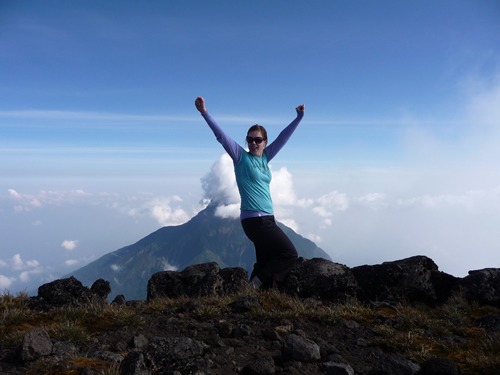 the hiker, date of hiking and the terms. The price of the Karisimbi hiking permit is $400 per person. It can be issued online or at the volcanoes national park headquarters. The permit can also be booked through your tour operator in advance or directly from the park during low seasons. The cost of the Karisimbi permit excludes the cost of the Karisimbi package. This package costs an extra $250 and includes cost of tents, supplies and special porters to cook while on top of the mountain. The permit cost also excludes the cost of accommodation before and after hiking the mountain. The Karisimbi permit excludes the cost of lunch, water, transport and a driver to take you from Kigali to the Volcanoes National Park and back.
the hiker, date of hiking and the terms. The price of the Karisimbi hiking permit is $400 per person. It can be issued online or at the volcanoes national park headquarters. The permit can also be booked through your tour operator in advance or directly from the park during low seasons. The cost of the Karisimbi permit excludes the cost of the Karisimbi package. This package costs an extra $250 and includes cost of tents, supplies and special porters to cook while on top of the mountain. The permit cost also excludes the cost of accommodation before and after hiking the mountain. The Karisimbi permit excludes the cost of lunch, water, transport and a driver to take you from Kigali to the Volcanoes National Park and back.


